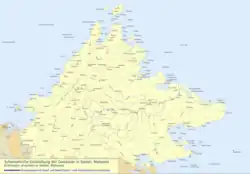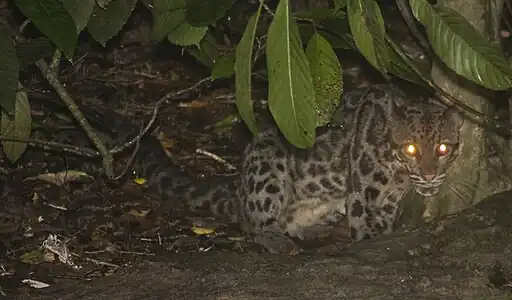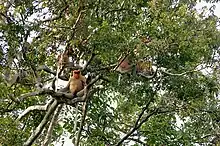| Kinabatangan River | |
|---|---|
.jpg.webp) A view of the Kinabatangan River | |
 The river source and tributaries are in dark blue. | |
| Native name | Sungai Kinabatangan (Malay) |
| Location | |
| Country | |
| State | |
| Division | Sandakan Division |
| Precise location | Northeastern Borneo |
| Physical characteristics | |
| Source | |
| • location | From mountains in Tongod District |
| Mouth | |
• location | At Kinabatangan District into Sulu Sea |
• coordinates | 5°37′34.1″N 118°34′21.4″E / 5.626139°N 118.572611°E |
• elevation | Sea level |
| Length | 560 km (350 mi)[1] |
| Basin size | 16,800 km2 (6,487 sq mi)[2][3] |
| Basin features | |
| River system | Crocker Range[4] and Maliau Basin[5] |
The Kinabatangan River (Malay: Sungai Kinabatangan) is a river in Sandakan Division, in northeastern Sabah, Malaysia. It is the second longest river in Malaysia, with a length of 560 km (350 mi) from its headwaters in the mountains of southwest Sabah to its outlet at the Sulu Sea, east of Sandakan.[n 1] The area is known for its high biodiversity, including its limestone caves at Gomantong Hill, dryland dipterocarp forests, riverine forest, freshwater swamp forest, oxbow lakes, and salty mangrove swamps near the coast.
Etymology and history
With the early Chinese traders' settlement around the river mouth area,[7][8] the name Kina Batañgan was used by the indigenous people of the area for the river, with the word Kina being a reference by the indigenous Dusun for the Chinese people.[9][10] The Orang Sungai traditionally lived along the river banks and were of mixed ancestry, including Dusun, Suluk, Bugis, Bajau as well the Chinese.[5] The earliest Chinese traders settlement on the banks of the Kinabatangan River had been established since the 7th century, where they traded in edible-nest swiftlet, beeswax, rattan and ivory.[5][8][9] In the 15th century, a sister of the Chinese Kinabatangan settlement leader married the sultan of Brunei.[5][11][12] During the British North Borneo era, the river served as the route for goods and timber exports, navigable for steam launches as well for smaller boats.[13] William Burgess Pryer attempted to establish a market at one location called Domingol along the river coast, but the plan did not flourish.[14]
Geology and ecology
The river area, including Labang and Kuamut, were formed by the Early and Middle Miocene periods, while large parts of the river system from the Maliau Basin were formed during the Early and Late Miocene.[15][16] Towards the river mouth, the area is made of Middle Miocene chaotic deposits.[16] The ecology of the upper reaches of the river has been severely disrupted by excessive logging and clearing of land for plantations, although the original lowland forest and mangrove swamps near the coast have largely survived, providing sanctuary for a population of saltwater crocodiles (Crocodylus porosus) and containing some of Borneo's highest concentrations of wildlife.[17] In many villages along the river, the demand for freshwater fish has always been high, and the livelihoods of villagers have greatly depended on the income from catches.[18] Each year, the lashing rains of the northeast monsoon cause the river to swell rapidly.[3] Unable to disgorge into the sea quickly enough, the river frequently overflows its banks and spreads across the flat land of its lower reaches, creating a huge floodplain.[5]
Conservation efforts

In 1997, 270 km2 (104 sq mi) of the lower Kinabatangan floodplain were declared a protected area.[19] Much of the deeper river area is protected under the Lower Kinabatangan Sanctuary, a 28,000-hectare (69,190-acre) reserve established in 1999 that provides a variety of habitats for flora, especially a freshwater swamp forest, mangroves, palms, and bamboo, as well as fauna, such as Hose's langurs, proboscis monkeys, orangutans, pig-tailed macaques, gibbons, slow lorises, elephants, Sunda clouded leopards, and rhinoceros.[5] In 2001, the lower Kinabatangan floodplain was upgraded into a bird sanctuary area through the efforts of non-governmental organisations (NGOs).[19] Following media attention after a decapitated elephant's head was found floating down the river in 2006, the protected area was gazetted as the Kinabatangan Wildlife Sanctuary through the Sabah Wildlife Conservation Enactment of 1997 under the purview of the Sabah Wildlife Department in 2009.[19][20]
Since the beginning of the modern era in the early 1950s until 1987, the lower Kinabatangan area has been subjected to commercial logging activities, and more than 60,000 hectares (148,263 acres) of its lowland rainforest have been developed into cocoa and palm oil plantations.[3] This resulted in severe pollution of the river, which greatly affected the lives of villagers who had depended on the river for their livelihoods, attracting the attention of the Ministry of Tourism, Culture and Environment of the government of Sabah.[21] In 2011, Nestlé launched a reforestation project of the riparian area along the Kinabatangan River in Sukau to create a landscape where people, nature, and agriculture activities could co-exist harmoniously in their need for water.[22] Most nature tourism in the Kinabatangan River area is concentrated around Sukau since it is accessible by road and offers comfortable accommodation to visitors prepared to pay for well-managed tours.[23]
Accessibility
The only bridge crossing the river is located at Federal Route Federal Route 13, about 108 km (67 mi) from Sandakan. A 350 m (1,150 ft) bridge linking Sukau with Litang and Tommanggong was planned but cancelled in April 2017 after opposition from conservationists, including David Attenborough, due to potential adverse effect on the local pygmy elephant population.[24][25] The river can be visited all year round, although it is often flooded during the wettest part of the year in December and January. From April to October during the main flowering and fruiting season, the climate is generally fairly dry and a good time to spot many birds and animals. During the northeast monsoon from November to March, there are often heavy showers during the afternoons which usually extended until December and January. Through the rainy season, it is possible to negotiate many of the river channels leading into the oxbow lakes, where there is a greater concentration of wildlife.[26]
.jpg.webp) The river in 1984.
The river in 1984. A signboard on a road bridge passing the river.
A signboard on a road bridge passing the river. The river seen from far.
The river seen from far..jpg.webp) Vegetation along the river.
Vegetation along the river. Bornean clouded leopard along the lower part of the river.
Bornean clouded leopard along the lower part of the river. A group of Proboscis monkeys by the river Kinabatangan
A group of Proboscis monkeys by the river Kinabatangan Orang Utan by the river
Orang Utan by the river
See also
Notes
- ↑ Kinabatangan River with 560 km (350 mi) length is the second longest river in Malaysia after the 563 km (350 mi) Rajang River in neighbouring Sarawak.[1][6]
References
- 1 2 Awang Azfar Awang Ali Bahar (2004). "Frequency Analysis of Riverflow in Sabah and Sarawak" (PDF). Civil Engineering Programme: 24. Archived from the original (PDF) on 24 May 2019. Retrieved 25 May 2019 – via Universiti Teknologi Petronas.
- ↑ "National Register of River Basins [List of River Basin Management Units (RBMU) – Sabah]" (PDF). Department of Irrigation and Drainage, Malaysia. 2003. p. 34. Retrieved 6 July 2019.
- 1 2 3 Sahana Harun; Ramzah Dambul; Harun Abdullah; Maryati Mohamed (2014). "Spatial and seasonal variations in surface water quality of the Lower Kinabatangan River Catchment, Sabah, Malaysia" (PDF). Journal of Tropical Biology and Conservation: 118. ISSN 1823-3902. Archived from the original (PDF) on 24 May 2019. Retrieved 25 May 2019 – via Universiti Malaysia Sabah.
- ↑ Tamara Thiessen (2008). Bradt Travel Guide – Borneo. Bradt Travel Guides. p. 205. ISBN 978-1-84162-252-1.
- 1 2 3 4 5 6 Fanny Lai; Bjorn Olesen (16 August 2016). Visual Celebration of Borneo's Wildlife. Tuttle Publishing. p. 409−419. ISBN 978-1-4629-1907-9.
- ↑ "Sarawak's Rajang River Delta". NASA Earth Observatory. 2016. Archived from the original on 24 May 2019. Retrieved 25 May 2019.
- ↑ David Levinson (1993). Encyclopedia of World Cultures. G.K. Hall. p. 80. ISBN 978-0-8168-8840-5.
- 1 2 Melvin Ember; Carol R. Ember (1999). Cultures of the world: selections from the ten-volume encyclopedia of world cultures. Macmillan Library Reference. p. 244. ISBN 9780028653679.
- 1 2 Sir Spenser St. John (1863). Life in the Forests of the Far East. Smith, Elder and Company. p. 327.
- ↑ Kam Hing Lee; Chee Beng Tan (2000). The Chinese in Malaysia. Oxford University Press. p. 383. ISBN 978-983-56-0056-2.
- ↑ Robert Nicholl (1995). From Buckfast to Borneo: Essays Presented to Father Robert Nicholl on the 85th Anniversary of His Birth, 27 March 1995. University of Hull. p. 190. ISBN 978-0-85958-836-2.
- ↑ "Sultan-Sultan Brunei" [Sultans of Brunei] (in Malay). Government of Brunei. Archived from the original on 28 January 2017. Retrieved 25 May 2019.
- ↑ David Sunderland (5 July 2017). British Economic Development in South East Asia, 1880–1939. Taylor & Francis. p. 5. ISBN 978-1-351-57306-1.
- ↑ Henry Ling Roth (2012). The Natives of Sarawak and British North Borneo. BoD – Books on Demand. p. 209. ISBN 978-3-86403-425-1.
- ↑ Allagu Balaguru; Gary Nichols; Robert Hall (2003). "The origin of the 'circular basins' of Sabah, Malaysia" (PDF). Bulletin of the Geological Society of Malaysia, Royal Holloway University of London: 337. Archived from the original (PDF) on 24 May 2019. Retrieved 25 May 2019 – via Geological Society of Malaysia.
- 1 2 Allagu Balaguru; Gary Nichols; Robert Hall (2003). "Tertiary stratigraphy and basin evolution of southern Sabah: implications for the tectono-stratigraphic evolution of Sabah, Malaysia" (PDF). Bulletin of the Geological Society of Malaysia, Royal Holloway University of London: 29. Archived from the original (PDF) on 24 May 2019. Retrieved 25 May 2019 – via Geological Society of Malaysia.
- ↑ Michelle Nordkvist (2003). "Anthropogenic disturbance along the Kinabatangan River in Borneo, Malaysia and the distribution and abundance of the saltwater crocodile (Crocodylus porosus)" (PDF). The Tropical Ecology Minor Field Study Working Group, Committee of Tropical Ecology. ISSN 1653-5634. Archived from the original (PDF) on 25 May 2019. Retrieved 25 May 2019 – via Uppsala University.
- ↑ Uwe Tietze; Food and Agriculture Organization of the United Nations (2007). Credit and Microfinance Needs in Inland Capture Fisheries Development and Conservation in Asia. Food & Agriculture Org. p. 131. ISBN 978-92-5-105756-8.
- 1 2 3 "Borneo's Kinabatangan [The River of Life]" (PDF). Anima Mundi. 2017. p. 14. Archived from the original (PDF) on 25 May 2019. Retrieved 25 May 2019.
- ↑ "Box 2. Kinabatangan – Corridor of Life (a case study)" (PDF). p. 12. Archived from the original (PDF) on 24 May 2019. Retrieved 25 May 2019 – via Ministry of Water, Land and Natural Resources, Malaysia.
- ↑ Kamar Nor Aini Kamarul Zaman (24 September 2007). "Kinabatangan River Needs Rescue From Pollution". Bernama. Malaysian Palm Oil Board. Archived from the original on 24 May 2019. Retrieved 25 May 2019.
- ↑ "Nestlé brings RiLeaf to the Kinabatangan River" (Press release). Nestlé. 26 September 2011. Archived from the original on 24 May 2019. Retrieved 25 May 2019.
- ↑ Charlotte J. Fletcher (2009). Conservation, livelihoods and the role of tourism: a case study of Sukau village in the Lower Kinabatangan District, Sabah, Malaysia (Thesis). Lincoln University. hdl:10182/1339.
- ↑ John C. Cannon (3 May 2017). "Over the bridge: The battle for the future of the Kinabatangan". Mongabay. Retrieved 25 May 2019.
- ↑ Jeremy Hance (21 April 2017). "David Attenborough's 'Guardian headline' halts Borneo bridge". The Guardian. Retrieved 25 May 2019.
- ↑ Billy Kon; King Li Lee (2004). Borneo's Tropical Eden: Sabah. Simply Green. p. 122. ISBN 978-981-05-1412-9.
Further reading
- "Kompendium (Data dan Maklumat Asas JPS)" [Compendium (DID Basic Data and Information)] (PDF) (in Malay). Department of Irrigation and Drainage, Malaysia. 2018. p. 26. Archived from the original (PDF) on 24 May 2019. Retrieved 25 May 2019.
- Carolyn Cowan (22 November 2023). "How scientists and a community are bringing a Bornean river corridor back to life". Mongabay.
External links
 Media related to Kinabatangan River at Wikimedia Commons
Media related to Kinabatangan River at Wikimedia Commons